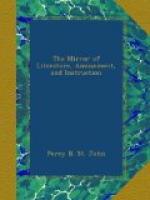[5] Travels in the South of
Spain. By William Jacob, Esq., M.P.,
F.R.S.
4to., 1811.
* * * * *
FINE ARTS.
STATUE OF MR. CANNING.
This colossal bronze statue to the memory of George Canning, has lately been placed in Old Palace Yard, Westminster; the cost being defrayed by public subscription. The artist is Mr. Westmacott. The figure is to be admired for its simplicity, though, altogether, it has more stateliness than natural ease. The likeness is strikingly accurate, and bears all the intellectual grandeur of the orator. Some objection may be taken to the disposal of the robes, and the arrangement of the toga is in somewhat too theatrical a style. We should, at the same time recollect, that the representation of a British senator in the costume of a Roman is almost equally objectionable. It would surely be more consistent that statues should be in the costume of the period and of the country in which the person lived. We know this will be opposed on the score of classic taste, which, in this instance, it seems difficult to reconcile with common sense.
The statue is placed on a granite pedestal, and stands within a railed enclosure, planted with trees and shrubs, and adjoining the footway of Palace Yard. The bronze appears to have been tinted with the view of obtaining the green rust which is so desirable on statues. The effect is not, however, so good as could be wished: the green colour being too light, and at some distance not sufficiently perceptible from the foliage of the trees which rise around the figure.
[Illustration: GEORGE CANNING.]
The situation of the statue has been judiciously chosen, being but a short distance from the senate wherein Canning built up his earthly fame. The association is unavoidable; and scores of patriotic men who pass by this national tribute to splendid talent may feel its inspiring influence. Still, rather than speculate upon Mr. Canning’s political career, we quote Lord Byron’s manly eulogium on the illustrious dead: “Canning,” said Byron, in his usual energetic manner, “is a genius, almost an universal one, an orator, a wit, a poet, and a statesman.” Again,
Yet something may remain, perchance, to
chime
With reason, and what’s stranger
still, with rhyme;
Even this thy genius, CANNING! may permit,
Who, bred a statesman, still was born
a wit,
And never, even in that dull house, could’st
tame
To unleaven’d prose thine own poetic
flame;
Our last, our best, our only Orator,
Ev’n I can praise thee.
It may be interesting to observe that the colour so much admired on bronze statues is fine dark green from the oxide formed upon the metal, which, being placed without doors, is more liable to be corroded by water holding in solution the principles of the atmosphere; “and the rust and corrosion, which are made poetically, qualities of time, depend upon the oxydating powers of water, which, by supplying oxygen in a dissolved or condensed state enable the metal to form new combinations.”—Sir H. Davy.




